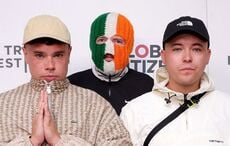“All songs are living Ghosts
And long for a living voice”
-- Brendan Kennelly
I thought of the verse above when recalling the fourth anniversary of the Dublin song collector Frank Harte’s passing on June 27, 2005 after putting the finishing touches on his last recording “There’s Gangs of Them Digging,” a collection of Irish working songs released by Hummingbird Records in 2007.
On Monday, June 29, Rita Keane of Caherlistrane, County Galway passed away at age 86 in a Galway hospital.
Before leaving this earth, however, the pair left a rich legacy for others to emulate and to keep the songs of Ireland inhabited by generations of singers who they touched with their own authentic voices and styles.
Harte was the more well-known and traveled singer and song collector said to have compiled over 15,000 songs in a database for his own and eventually an historical archive accessible for others to delve into and keep those songs alive.
The quality of his voice, while distinctive, was not what drove people to seek him out in teaching workshops, festivals, concerts or any of his six recordings over the years.
Harte grasped the essence of a song and the historical context which gave it greater resonance no matter whether it was political, swashbuckling, romantic, humorous or tragic, and he felt that was more important to convey than a catchy melody or air which could detract from the overall message contained in the words.
He preferred to sing without accompaniment, save for the last part of his life when his last four CD’s were produced and deftly accompanied by Donal Lunny for Hummingbird Records.
His impact on many of the major Irish singers today like Paul Brady, Mary Black, Niamh Parsons, Karan Casey and the Goilin Singing Club can still be very much recognized in their music with or without accompaniment or acknowledgment.
Rita Keane was a sister of Sarah Keane from Galway in the Conamara region near Headford. The Keane family has been one of Ireland’s foremost families in Irish traditional music, going back over six decades first with a ceili band and then as one of the leading forces in traditional singing.
Rita and Sarah made two albums displaying their unique -- for Ireland anyway -- singing in unison style which reflected the heartfelt way they collected and preserved songs around their part of the world.
The first was called “Once I Loved” and the second was “At the Setting of the Sun” which was recorded 20 years after the first one.
Many singers all over Ireland were influenced by their honest, authentic voices, but none more so than their niece Delores Keane and nephews Sean and Matt Keane who went on to have great careers in Irish music, having been reared around their two aunts Rita and Sarah and steeped in the tradition they espoused so fiercely.
The Keane family being musicians had an added advantage in approaching songs, and their locality and fluency in the Irish language provided for more ornamentation in their singing and more of the sean nos aspects that could not be said of Frank Harte.
Three years ago in 2006 Rita and Sarah Keane were recognized by TG4 for a Lifetime Achievement in Irish Traditional Music, and Harte won their acclaim as Singer of the Year in 2003.
It is important to note the above because singers are very important people when evaluating how our Irish heritage gets passed along from one generation to another. As Harte was famous for saying, “Those in power write the history while those who suffer write the songs and we Irish have an awful lot of songs.”
Not everyone can play the jigs and reels, and singers of every stripe and influence can bear witness to how broad and insightful our culture can be through the world of song.
Like all things traditional, singing must be cared for and tended to and continue to prosper in the right hands, and I am glad to say that there are many great singers out there upholding the tradition.
At the 2007 Smithsonian Folklife Festival when Northern Ireland was recognized as a region of influence on America, there was an outstanding array of singers as part of a 160 strong compliment of artists and crafts people.
One particular contingent from Mullaghbawn area of South Armagh stood out in my mind as worthy candidates to share their talents with budding singers in the Catskills and those who appreciate great singing and creativity and a bit of humor. Experienced singers like Len Graham, Patricia Flynn and the 82-years-young Mick Quinn provided a formidable task force to take on the town of East Durham.
Graham was born in Glenarm, County Antrim and now resides in Mullaghbawn with his wife Pádraigín Ní Uallacháin, who is also a traditional singer. Both specialize in the songs of Ulster.
Graham is the most well-known of the trio, having visited the U.S. many times before on solo tours and in concert with other performers like Cathal MacConnell and his one-time band Skylark.
His singing and sourcing his songs are first-rate and very much in the mold of Harte and the Keanes, and his associations with many of the finest singers in the North like Joe Holmes, Eddie Butcher, Geordie Hanna and Sarah Anne O’Neill, MacConnell and storyteller John Campbell place him in the vanguard of tradition-bearers today.
His work on Northern Ireland songs is particularly noteworthy and valuable these days and he has appeared on 20 albums, including three solo CDs.
Patricia Flynn, born in Drumintee in South Armagh and now residing in Mullaghbawn, is also a very fine singer (one CD entitled “Stray Leaves”) of songs from the area and beyond. As one of Armagh’s local music promoters, she help found and run the Slieve Gullion Festival of Traditional Singing which served a major role in the preservation and promotion of Northern Ireland Song.
Mick Quinn was born in Carricknagavna in South Armagh in farming country, and he honed many of his stories and songs from his father and the barn and flax dances in his neighborhood back in the 1940s.
He is a highly respected author of poetry, stories and songs in a comedic vein and a wonderful tradition-bearer in the Irish music scene and the uncle of box-player Martin Quinn who appeared in the Catskills a couple of years ago.
Graham and Flynn will teach singing workshops in the Catskills and perform in the evening concerts and sessions along with Quinn who will serve in a master musician’s role all week next week. They will all participate in a special workshop on Northern Ireland song on Thursday afternoon in the Shamrock House starting at 4 p.m.
Helping to keep the singing tradition alive and well in the U.S. is Brian Hart (Brian O hAirt), a St. Louis native who has studied traditional music, song, dance and the Irish language through graduate programs in Ireland.
In 2002 in Listowel, he was the youngest and first ever American to win the All-Ireland Senior Singing competition. He has put all that education to good use in establishing Sean Nos Milwaukee, a leading celebration of singing in the sean nos tradition, especially in the Irish language and he will teach singing in Irish in the Catskills. He is also a very fine concertina and sean nos step dancer and member of the band Bua.
While the voices of Frank Harte and now Rita Keane have been stilled, their spirit is very much with us especially in the Catskills with the Frank Harte Singing Club established in his memory in 2007.
Raising voices in such a community as that strengthens the living tradition and assures that Ireland’s history in song and story will remain as powerful as it has been in the past.
For more information on the Catskills Irish Arts Week contact 518-634-2286 or visit www.irishvillage.com.




Comments